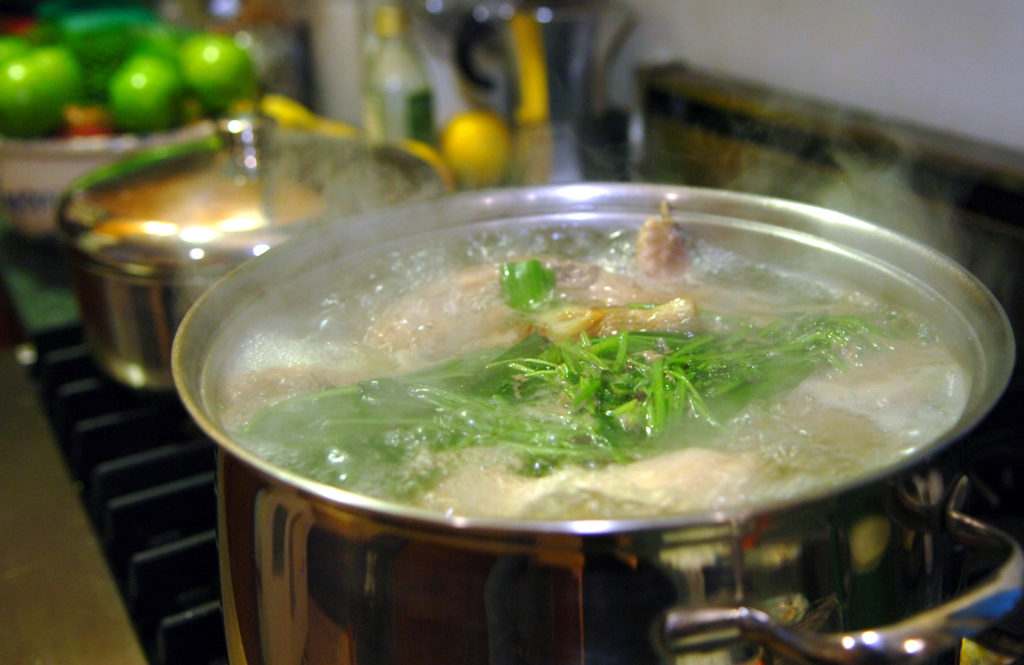How to make bone broth

Bone broth is having a moment as a hipster health food, but broth has long been a kitchen staple for preparing comfort foods such as soup or risotto. It’s also used for braising vegetables and meat and cooking flavorful grains such as rice and quinoa. Grocery stores may be running low on shelf-stable packs of broth, so making your own is an easy and inexpensive way to bolster your stockpiles and help you cook for however long the social distancing measures are in effect.
Aside from a generous pile of meat and vegetable scraps as well as some spices, all you need to prepare broth is a roasting pan, a strainer and a large pot. Here’s how to make the most of the scraps in your kitchen by turning them into broth.
What to save for broth
All sorts of bones can be used to make broth, from large beef or pork bones with thick marrow cores to delicate chicken bones. You can save whole bird carcasses if you roasted a whole bird (pandemic aside, making a turkey bone broth after Thanksgiving should be a family tradition). Chicken feet also work great for broth if you have them available at your grocery store. Leftover shrimp shells, crab shells, lobster shells and fish bones can also be used to make delicious broth. You can even mix different kinds of bones to give your broth a more interesting flavor.
You also want to save vegetable scraps. Here is a list of things that will make your broth delicious.
— The skins and ends of onions, shallots, garlic, scallions and leeks. However, don’t use too many skins from onions or garlic, as it will give the broth a bitter flavor.
— Corn cobs.
— The ends and peels of root vegetables such as carrots, parsnips, potatoes and beets.
— The ends, leaves and fronds of stalk vegetables such as celery, asparagus and fennel (though fennel has a strong flavor, so use sparingly).
— Mushroom stems and scraps.
— Stems of herbs (again, be conscious of how many you use. Herbs like rosemary will give the broth a very strong flavor).
— Pepper cores (though hot peppers may make the broth spicier than you can handle, so be warned).
— Wilting vegetables that are not yet spoiled or moldy.
Make sure all scraps are thoroughly washed and dried before freezing to keep any dirt out of your homemade broth.
You want to skip members of the Brassica family — cabbage, Brussels sprouts, broccoli, cauliflower and radishes — as those can make your broth bitter.
You should also avoid using scraps of meat and vegetables that you don’t like. The flavors will be enhanced in the process, and you are not likely to enjoy the broth if you don’t enjoy its ingredients.
Another food “scrap” that would be good to save for homemade broth is Parmesan rinds, which add a rich umami flavor.
Save scraps for several meals — more than a pound of bones and a few cups of vegetables should do — to prepare a flavorful broth. Use a sealable plastic bag, reusable sealable bag or even clean spaghetti sauce jars to gather and store these items in the freezer until you are ready to make broth.
How to make bone broth
First, roast the bones in order to bring out the flavor. One to two pounds of bones should be sufficient, depending on how strong you want your broth to taste. Start by roasting the bones at 400 degrees for 30 minutes to an hour.
Add the bones, vegetable scraps (a couple of cups will do it) and the cheese rind if you are using it to a large pot. You also want to use some aromatics to bring out the flavor, like a few smashed garlic cloves, peppercorns or bay leaves.
If you want, you can tie all the ingredients up into a cheesecloth bundle, which will make the solids easier to remove at the end of the process. If not, just have your fine mesh strainer ready.
Fill the pot with about 12 to 16 cups of water. Finally, add a splash of apple cider vinegar or lemon juice. The acid will not only balance the flavor, but it also will help the bone cartilage gelatinize and draw out healthy minerals.
Next, bring the water to a boil on the stovetop. Then, reduce the heat to low and bring to a simmer.
Cover the pot and let the broth simmer for 8 to 24 hours. The longer you simmer the broth, the more collagen will be extracted from the bones, giving the broth a silky texture.
Once you have simmered the broth for as long as you desire, skim any fat or foam from the top, strain (or remove the cheesecloth bundle) and discard the solids. If you want to add salt before storing your broth, do so now, to taste. Let the broth cool slightly before handling and storing.
How to store bone broth
Once your broth has cooled, there are several ways to store it if you don’t plan on using it right away. The first is refrigerated in jars. Pour the cooled broth into glass mason jars or clean, upcycled spaghetti sauce jars and store in the refrigerator for a week or so.
You can also freeze your broth. One handy technique to do so in measured portions is to pour the broth into ice cube trays. Once frozen, pop the cubes into a sealed storage bag in the freezer for up to six months.
